

Lake Los Carneros ARDF on 11/22/08
Photos above and report below by Joe Moell KØOV.
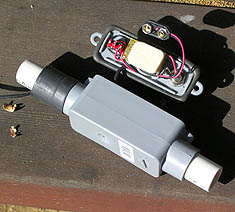 Marvin Johnston KE6HTS, organizer for this event, tried something different. An hour before the hunt, he had a table laid out with tools and soldering irons, plus tape-measure yagi and attenuator kits for sale. Three hams from the Glendora and Chino Hills area took him up on the offer and finished their RDF equipment in short order. Then Marvin and some of the other experienced hunters helped the newcomers check out their gear and learn to use it on a very short 3-transmitter course that Marvin had laid out.
Marvin Johnston KE6HTS, organizer for this event, tried something different. An hour before the hunt, he had a table laid out with tools and soldering irons, plus tape-measure yagi and attenuator kits for sale. Three hams from the Glendora and Chino Hills area took him up on the offer and finished their RDF equipment in short order. Then Marvin and some of the other experienced hunters helped the newcomers check out their gear and learn to use it on a very short 3-transmitter course that Marvin had laid out.
Then it was time to send everyone out on the standard 5-fox course, with transmitters all around the lake. The training paid off, because everyone did quite well.
2-METER RESULTS, FIVE TRANSMITTERS
Name/Call Foxes Time
Jay Hennigan WB6RDV 5 0:45:17
Bill Smathers KG6HXX 5 0:47:00
Scott Moore KF6IKO 5 0:47:10
Joe Moell KØOV 5 1:02:49
DeAngelo Fernandez KG6YGD 5 1:39:15
B. B. Odenthal KG6YGC 5 1:44:15
Julianne Walsh KI6DYX 5 2:13:27
Jeremy Neal KG6YGB 4 1:59:52
Sam Vigil WA6NGH 3 1:13:45
Julianne would have had better time if she had not had to return to the start for a fresh battery midway in the hunt. Sam had to cut his hunting short to get back home.
Thanks to everyone who participated. The building workshop was so successful that it will be included in future events.
Joe Moell KØOV
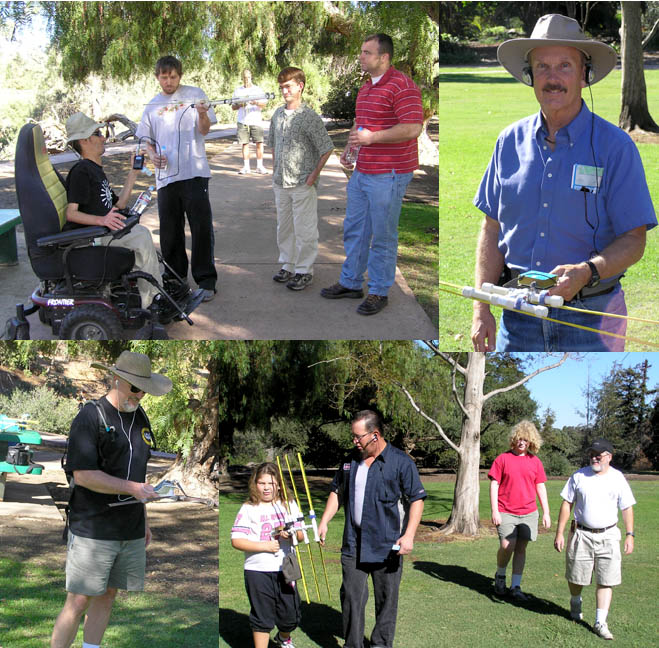
Balboa Park ARDF on 11/8/08
Photos above and report below by Joe Moell KØOV.
Balboa Park in San Diego has a little bit of everything, from many museums to a world-famous zoo to a vintage outdoor concert pipe organ. On November 8, it had an enthusiastic group of hidden transmitter hunters. Organizing this event was Bill Elkerton W6ZM, with plenty of help from family members. Bill has attended several of our Los Angeles and Orange County radio-orienteering sessions and has learned well. His hunt followed most of the guidelines for international-rules ARDF events.
This beautiful park near Old Town is huge, but the hunt was confined to the 167 acres west of Highway 163. (Well almost, because fox #1 was accessible only by a footbridge over the highway to a nearby spot on the east side.) Bill urged hunters to stick to the trails and he was right, because doing otherwise meant some treacherous climbing and descending. Unfortunately, the map showed only major trails, so it took some luck to find the little paths that went close to the transmitters.
By international standards (a point-to-point computation), the 5-fox two-meter course was 2.9 kilometers long with 340 feet of climb. However, it probably required twice that much travel to get to the transmitters by the trails. This may explain why no full-course times were less than two and a quarter hours. Six of the ten individuals and teams found all of them, working up a great hunger for the carne asada and some very decadent desserts.
W6ZM has posted the results, photos, and locations of the transmitters on the web.
Thanks to Bill and his helpers for setting the first ARDF event in San Diego County. I hope it won't be the last, and that we'll see hunters from that area at the next USA championships.
Joe Moell KØOV

Huntington Central Park ARDF on 10/18/08
Photos above by Joe Moell KØOV and April Moell WA6OPS. Report below by Joe Moell KØOV.
 The recent hot weather streak took the weekend off, so it was quite pleasant at Huntington Central Park for ARDF on October 18. There weren't any other major activities in the park this day, so everyone had easy access to the trails. They also encountered plenty of spiders in the brush.
The recent hot weather streak took the weekend off, so it was quite pleasant at Huntington Central Park for ARDF on October 18. There weren't any other major activities in the park this day, so everyone had easy access to the trails. They also encountered plenty of spiders in the brush.
Many of the regulars were out of town or had other activities, so we were able to devote lots of attention to a group of newcomers from Huntington Beach CERT, including Michael Binder KI6FME, Kathleen Nelson K6IBH, Peter Petrelis KI6AEH and Virginia Petrelis KI6AEI. They were encouraged to try ARDF by their instructor, John Fort W6SIN, who also came out to visit. With one of their receivers, plus one of my tape measure beams and active attenuators, they found the first beginner fox with some help, the second with less help, and the third pretty much by themselves. I hope they will all have their own antennas and attenuators ready for our next event.
I planned the regular two-meter ARDF course to be shorter than usual, to encourage more newcomers to try it. Fox #5 refused to come on at start time, so that made the course even shorter. But it still took hunters longer than usual, even though this park doesn't have any hills to bounce the signals. I'm not sure why it appeared so difficult. Here are the results:
2-METER RESULTS, FOUR TRANSMITTERS
Name/Call Foxes Time
Marvin Johnston KE6HTS 4 1:45:01
Roman Kamienski KG6QMZ 1 2:24:57
Julianne Walsh KI6DYX 1 2:45:09
Marvin Johnston KE6HTS was the only one who went after the 80-meter transmitter. He found it and got back to the start in 20 minutes and 8 seconds.
April and I want to thank everyone who came out and gave radio-orienteering a try.
Joe Moell KØOV
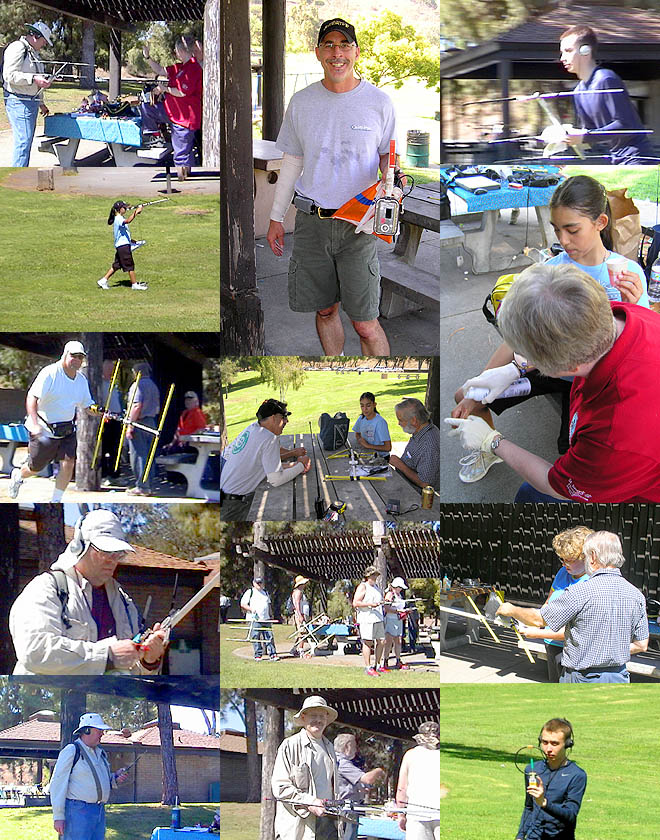
Bonelli Park ARDF on 9/20/08
Photos above and report below by Joe Moell KØOV.
What better way to welcome back on-foot transmitter hunters from the world championships than by having a hunt for them? That's just what happened on September 20 at Bonelli Regional Park near the LA County Fairgrounds. While not searching for radio foxes, participants heard stories of the 2008 World Championships in Korea from Jay Thompson W6JAY, Richard Thompson WA6NOL and Scott Moore KF6IKO.
For the beginners, I put out four little two-meter transmitters. For the experienced foxtailers, Marvin Johnston KE6HTS set out a full two-meter course, complete with electronic scoring. He was experimenting with Microhunt transmitters, which are much easier to carry around and set up than regular ammunition-can foxboxes. At about 50 milliwatts, their power was much lower, but range didn't suffer much, thanks to the elevated turnstile-type horizontally-polarized antennas.
2-METER RESULTS, FIVE TRANSMITTERS
Name/Call Foxes Time
Jay Thompson W6JAY 5 1:37:02
Bill Elkerton W6ZM 5 2:33:48
Roman Kamienski KG6QMZ 5 2:38:48
Scott Moore KF6IKO 4 1:38:32
Bill Smathers KG6HXX 3 2:27:40
Tom Gaccione WB2LRH 2 3:36:52
Accompanying Bill Elkerton W6ZM were Robin Elkerton KC6LEA, Bryan Elkerton KI6DUR and Richard Sherwood N6RU.
Also getting some practice on the advanced course were Monique and Tim Beringer, KI6RVT and KI6RVS.
Meanwhile, two newcomers were learning the ropes by finding the beginner transmitters within the 400-meter circle on the map. They were Julianne Walsh KI6DYX of Goleta and first-timer Brad Wilson N3BSW from Diamond Bar.
My 80-meter transmitter was one kilometer away. Two of the hunters found time to go after it. Electrical noise from the nearby power lines was higher than usual, which may explain why times were longer than I anticipated.
80 METER RESULTS, ONE TRANSMITTER
Name/Call Time
Jay Thompson W6JAY 25:35
Scott Moore KF6IKO 36:30
Thanks to the hunters who helped pick up the transmitters at the end.
Joe Moell KØOV
Mt. Pinos ARDF on 8/23-24/08
August is a great month at Mount Pinos in the Los Padres National Forest, as long as you bring a little sunscreen and bug repellent. The second training camp for ARDF Team USA members took place on August 23 and 24 where the deer and the antelope play -- and sometimes dash out in front of your vehicle at dawn and dusk. With a starting point of 8425' elevation, everyone got a good cardio workout.
Marvin Johnston KE6HTS set out a full two-meter course Saturday morning. This time it was 65-year-old Bob Cooley's turn to beat 57-year-old Jay Hennigan on both bands. Each of them had excellent runs and improved times, so they are ready to take on the rest of the world.
Sam Vigil had equipment problems, but he has since figured out the autoranging feature of his VK3YNG receiver and will be ready for the next event.
Tom Gaccione WB2LRH arrived as the others were finishing, so he took on the task of RDFing and bringing back two of the transmitters.
After snacks and recovery of the other transmitters, Marvin set out a low-power sprint course in the campground. The hunters' goal was to find each fox during its first one-minute transmission of the sequence. A perfect run would take just five minutes, plus a couple of minutes to return to the finish line. Jay started out on the first cycle and Bob on the second. I was going to try it on the third cycle but before that, everyone realized that MOI had disappeared from the air. Soon it reappeared at about the same time in the cycle as MOH's transmissions. The sprint sputtered to a stop as we all tried to detect and track the wayward MOI. As it turned out, a motor home dweller in the campground had removed it from the bush. He said that he thought another camper had inadvertently left it behind at his campsite and he was going to give it to the Ranger. Marvin got his Microhunt transmitter and flag back, and that concluded the radio-orienteering action for the day.
At suppertime, everyone gathered at a grill by the lake in Frazier Park for Marvin's Santa Barbara style tri-tip roasts and all the fixings. It was almost dark by the time they were served, but worth the wait.
Marvin had repaired and tuned up all his 80-meter transmitters in the last month and they all worked perfectly on Sunday morning. So did my finish line transmitter. The first hunter set out at exactly 10 AM and the hunt went quickly with everyone finding them all. Hunters still had enough stamina left to go out and pick them up afterwards.
Thanks again to Marvin for organizing the training camp and to April Moell WA6OPS, who was well prepared for medical emergencies that fortunately did not occur.
Joe Moell KØOV
Mt. Pinos ARDF on 7/19-20/08
The first of two ARDF training camps took place at Mt. Pinos in the Los Padres National Forest July 19-20. It was especially for ARDF Team USA members who are training for the World Championships in Korea, but open to anyone who could successfully navigate the woods at high altitude. Here is the report from organizer and course-setter Marvin Johnston KE6HTS:
"The weather was outstanding and made for a very pleasant run on both
days. Several people camped out at McGill and the others stayed at a motel,
preferring the option of showers!
"I got to the start a bit late on Saturday for the 2m hunt, but the event itself
was trouble-free except for late starts. Jay Hennigan WB6RDV had to arrive late
because he ran a 15K race earlier that morning. Scott Moore KF6IKO went with him to start him on 2m, and the only
problem was that Jay finished the course after the epunch controls had turned
off at 2 PM. But he punched the map for those last two controls and all was
well."
"Because we were running late, I changed the format of the afternoon sprint from finding
one transmitter on each cycle to finding each transmitter on the approprate
minute. The goal was to have the sprint done in about 7 minutes or so, start to
finish, for each competitor. Competitors had to get a bearing and very quickly find
the flag. To make it a bit easier this time, I didn't use pin punch, and the
rule was it would count as long as the competitor was within about 10 meters of the
flag. This was a learning experience for all of us. Most people overran #1
without finding it, thinking another flag (#5) was #1. The next time, I'll make
sure the flags are numbered and we will use pin punch so that type of mistake
won't happen again.
"We found out that open fires were not permitted because of the extreme fire
danger, but I had a backup plan and we all went down to the County Park in
Frazier Park for the barbecue. After almost everyone worked to get the grill so it would stay put
when I put the weight of the tri-tips on it, the cooking went well and we all
filled up until most of the food was gone.
"The main disaster was on the 80m hunt. Transmitter #3 had gone bad at the Lake Tahoe
US ARDF Championships, and I had not repaired it, since we rarely hold 80m hunts.
While checking that one out in Santa Barbara, I hooked power to one of the other transmitters backwards,
smoking it. I ordered and received the replacement parts,
got #3 fixed, but I could not get the smoked #2 to work properly. So we ended up
running the 80m hunt on 4 transmitters. All seemed well when I set the transmitters, but then I couldn't hear #5 at the start. I went back to
check it out and everything appeared to be working
properly. It turned out that the power was so low that it could only be heard for
a half-kilometer with a sensitive receiver. So I just gave everyone a rough bearing of
what they would have heard, and we started. Everything went relatively smoothly
from that point on."
"It was decided that our final training camp for 2008 will be at Mt. Pinos on the third weekend
of August. It will be the same format but the courses will be different, of course. As we did this time,
we will have the tri-tip BBQ at the county park in Frazier Park, since the forest
service banned fires due to the extreme fire danger. The cost will again be
$5.00 for the maps and use of epunch equipment. Depending on how many people
show up, it will be $5.00 or so for the tri-tip BBQ."
Marvin Johnston KE6HTS
Fairway Village ARDF on 6/14/08
A new site and a lot of newcomers to transmitter hunting made our June 14 event a big success. David Corsiglia WA6TWF of the SuperSystem UHF repeater association hosted us in the clubhouse of Fairway Village, a residential community where he lives in north Fullerton. This was the first time that spectators could be in air-conditioned comfort as they dined and watched transmitter hunters go out into the bright sunshine of this 83-degree day.
With help from some other SuperSystem members, David provided a great barbecue lunch. There were the usual hamburgers and hot dogs, plus excellent Korean-style ribs and all the fixings, including David's famous "mother-in-law" baked beans.
Both before and after the lunch, David kept encouraging every SuperSystem member to try finding the tiny and flea-powered 218 MHz "ditter" transmitters that he had hidden in unusual spots in the subdivision, such as a mailbox, traffic cone, water sprinkler, tree, etc. It was such a busy time that April and I couldn't log all the people that took the challenge, but I know that all six receivers that David and I provided were in rotating use for much of the late morning and early afternoon by many individuals and families.
My four two-meter beginner transmitters didn't get a lot of attention this day, but I'm hoping that many of the folks who tried the ditters and had a good time will come out and try two meters at one of our future events. Better yet, I hope they will want to build their own tape-measure yagis and offset attenuators so they can hunt at their leisure with their own equipment.
Then at 12:30, the five advanced course transmitters came on the air. The color map that hunters were given showed that the hunt area included Fairway Village plus the nearby Fullerton Sports Complex and Brea Dam Recreation Area, a total of about 450 acres. This turned out to be a challenge worthy of the three attendees who are training for the ARDF World Championships in Korea this September. Point-to-point distance for the full course was 4.8 kilometers, if your RDF was perfect. Total climb was more than 350 feet because the area includes both the depths of the flood basin behind the Brea Dam and the heights of the residential areas. Contour running was limited by the irregular boundaries. And there was very little shade out there! On the other hand, this may have been the first time in one of our soCal events that runners could take a shower right after they finished!
Here are the official results of the advanced hunt:
Monique Beringer and family started late and were very close to #5 when the RDF set batteries died. By the time they got back to get fresh batteries, it was almost time for the transmitters to go off.
Thanks to David WA6TWF for hosting this event and to April WA6OPS for handling all the scoring and medical duties as usual. Thanks to all the attendees who provided additional food and were good sports as they hunted those radio foxes. It was great to have hunters from as far away as Santa Barbara and the Bay area. Let me know if you would like to have another hunt at this site some time.
Joe Moell KØOV
Heartwell Park Scout RDF on 6/7/08
For the sixth year, Scouts of all ages had the opportunity to try transmitter hunting at no charge during the Long Beach Scout-O-Rama in Heartwell Park on June 7. RDF was part of a comprehensive Amateur Radio display set up by Associated Radio Amateurs of Long Beach (ARALB) and Orange County Hospital Disaster Support Communications System (HDSCS). There were six standalone hidden transmitters on the 2-meter band plus six pulsed 218 MHz wildlife tag transmitters. There was also a simple 3-fox course on the 2m band.
Teaching RDF to the Scouts were (in alphabetical order) Tom Gaccione WB2LRH, Marvin Johnston KE6HTS, Joe Moell KØOV, Jay Thompson W6JAY and Richard Thompson WA6NOL. All of the teaching hams were kept very busy helping groups of two or three Scouts at a time.
Irvine Park Transmitter Hunting on 5/18/08
Hidden transmitter hunting on foot was part of an Amateur Radio display to the general public at the Orange County Emergency Medical Services picnic at Irvine Regional Park on Sunday, May 18. This event ("EMS Appreciation Day") was four hours of free food and fun for families of EMS employees. It was also open to all other park-goers. There were displays by ambulance companies and other EMS-related organizations. Several hundred persons attended.
This communications and foxhunting display was organized by the Hospital Disaster Support Communications System (HDSCS), which is an Amateur Radio Emergency Service specialty group that provides backup communications to 35 hospitals in the county. Display visitors learned how ham radio serves the hospitals. They also discovered how radio direction finding provides important services such as downed aircraft location, stuck transmitter remediation and wildlife tracking for research. A dozen little transmitters were scattered around the picnic area and visitors of all ages could seek them out with provided equipment.
Thanks to Jay Thompson W6JAY, Richard Thompson WA6NOL and Monique Beringer for helping me demonstrate direction finding to the public at this event.
Joe Moell KØOV
Tri-City Park ARDF on 5/17/08
This year's annual Orange County "Antennas In The Park" event brought together three ham radio organizations: Fullerton Radio Club, Western Amateur Radio Association and Fam-Comm Amateur Radio Association. There was lots of food and radio talk, but the high heat reduced the transmitter hunting ambitions of most attendees. The temperature slowly climbed throughout the day, peaking at 105 around 2:30. Then a cooling breeze came up and dropped the temperature about ten degrees.
Four close-in foxes on two meters went on around 10 AM for the benefit of first-timers. Julianne Walsh KI6DYX found all of them but she had to leave before the main event.
The five-fox international-rules hunt on two meters started at 12:30 PM and had these results:
Throughout the day, here were four tiny beeping foxes on the 222 MHz band, investigated by Robert Gimbel KG6WTQ and some others.
The annual Foxhunting Weekend cake was a big hit, as always. Thanks to April Moell WA6OPS for providing it. Also thanks to Monique Beringer for helping April with start/finish timing.
Joe Moell KØOV
Schabarum Park ARDF on 4/19/08
Our first radio-orienteering event in Schabarum Regional Park was ten years ago. Over the years, we have learned that its hilly trails are extra slippery in the rain and extra tiring in the hot sun. With the large changes of elevation in the Powder Canyon Wilderness part of the course, this is one of the most difficult venues in southern California. Fortunately, the weather on April 19 was close to perfect. The temperature never got out of the 60's.
Marvin Johnston has added a significant amount of wilderness area to LAOC's large orienteering map, but a lot of that vegetation has changed. This spring, the mustard plants are over eight feet tall in places and extra thick. Some of the smaller trails are overgrown and nearly impossible to locate. That provided an extra challenge for the intrepid foxhunters.
Even though the lowlands of Schabarum are fine for newcomers, my beginner transmitters went unfound. Only advanced hunters showed up this time.
Championship ARDF courses have well-separated start and finish locations. To win, a hunter must carefully choose a route from start to finish that takes him or her to each required transmitter in the shortest distance without backtracking. For the first time, we started all the advanced-course participants from the southeast corner of the mapped area. Start elevation was 640 feet above sea level and finish was at 600 feet. But there were some 1130-foot high plateaus and 500-foot lowlands in between.
The starting corridor was up the big trail in the direction of fox #1, to the west. Unfortunately, the battery on Marvin's fox #1 failed, so it ended up being a 4-fox hunt for everyone. Here are the results:
My 80-meter fox was only half a kilometer away, but it was difficult to get to by just following the bearing in a straight line. Bob Cooley KF6VSE was the only hunter to have enough time and stamina left after the two-meter hunt to take it on. He got there and back in 31 minutes.
Thanks to Marvin and April for making this a very successful practice for ARDF Team California as these hunters prepare for the USA Championships in Texas.
Joe Moell KØOV
Hillcrest Park ARDF on 3/8/08
There is good news and bad news about Hillcrest Park in Fullerton. Major construction to rebuild the big reservoir is complete. It is covered with turf and all the roads in the park are open. On the other hand, there is so much new landscaping that many of the great places to conceal transmitters are gone, at least for the time being. Nevertheless, I managed to find good places for 11 transmitters. Besides the course of five international-rules foxes for two meters, there were three two-meter transmitters for beginners, an 80-meter ARDF transmitter and two little pulsed transmitters on the 222 MHz band.
Beautiful warm weather brought participants from as far away as Santa Barbara and the San Francisco Bay area. A short ARDF course like this should result in some times well under an hour, but the experts' times all were in the one-hour range (12 transmitter cycles). The cause, apparently, was reflections from the hills. All of the 2-meter transmitters were in low- or medium-elevation places, so their signals were all blocked by hills from the start and from each other. Bob Cooley reported that he spent extra time going to the top of the hills to try to get better bearings.
The 80-meter transmitter was just on the other side of the big reservoir hill. Two participants went after it.
Tom Fiske AA6TF successfully found both of the little 222 MHz transmitters.
Thanks to April Moell WA6OPS for keeping track of the timing. Fortunately, her medical skills weren't needed this time. Also thanks to Marvin Johnston KE6HTS and Bob Cooley KF6VSE for helping gather the transmitters afterwards.
Joe Moell KØOV
Lake Los Carneros ARDF on 2/2/08
The windy and stormy weather held off until evening, making February 2 a perfect day for ARDF in the Santa Barbara area. It was good to see first-timers Brad, Steve, Keith and Julianne, along with returning newcomer Owen and his dad. Everyone tried the two-meter five-fox ARDF course that was set by Marvin Johnston KE6HTS.
Lake Los Carneros is an ideal site for beginners to learn how to plan an ARDF route that efficiently gets them to each of the five transmitters and back in the minimum time. It's mostly level, but recent rains have swelled the lake and made some of the area into marsh.
Several of the participants finished the two-meter course in time to try finding the 80-meter transmitter that I set out.
Thanks to everyone who came out!
Joe Moell KØOV
Go to International-Style Foxhunting Comes To The Americas -- How we're getting the ball rolling
Go to Equipment Ideas for Radio-Orienteering -- Simple and inexpensive receiving and transmitting solutions
Go to Foxhunting for Scouts -- Let's get the kids involved
Go to Local ARDF Contacts -- Links to hams and groups that are doing international-style foxhunting in North America and around the world.
This page updated 9 May 2009
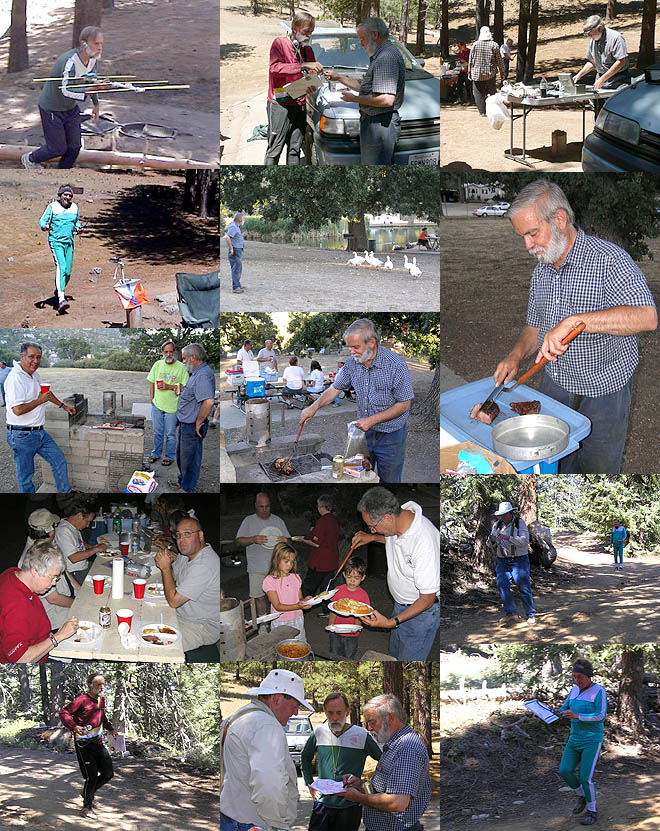
Photos above by Joe Moell KØOV and April Moell WA6OPS. Report below by Joe Moell KØOV.
2 Meter Results, 180 minute limit, 5 transmitters
Name/Call Foxes Time
Bob Cooley KF6VSE 5 1:33:50
Jay Hennigan WB6RDV 5 1:38:05
Bill Smathers KG6HXX 2 2:55:40
Scott Moore KF6IKO 2 3:04:25 (OT)
Sam Vigil WA6NGH 0 2:20:11
80 Meter Results, 180 minute limit, 5 transmitters
Name/Call Foxes Time
Bob Cooley KF6VSE 5 1:05:32
Jay Hennigan WB6RDV 5 1:37:00
Scott Moore KF6IKO 5 2:01:55
Bill Smathers KG6HXX 5 2:05:05
![]()
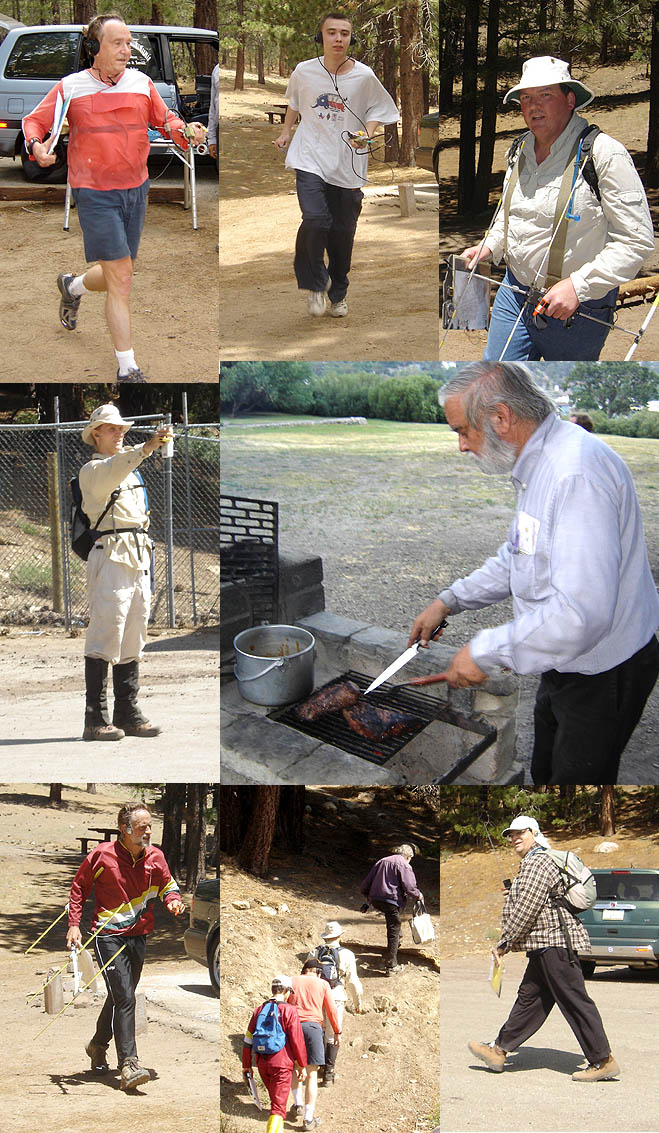
Photos above by Richard Thompson WA6NOL
2 Meter Results, 180 minute limit, 5 transmitters
Name/Call Foxes Time
Jay Hennigan WB6RDV 5 1:40:14
Bob Cooley KF6VSE 5 1:47:58
Jay Thompson W6JAY 4 1:22:05
Scott Moore KF6IKO 4 1:47:11
Bill Wright 2 2:11:17
Brad Weyers 4 3:18:48 (OT)
Bill Smathers KG6HXX 0 3:54:58 (OT)
80 Meter Results, 180 minute limit, 4 transmitters
Name/Call Foxes Time
Jay Hennigan WB6RDV 4 53:59
Jay Thompson W6JAY 4 59:56
Bob Cooley KF6VSE 4 1:05:52
Brad Weyers 4 1:20:55
Bill Wright 4 1:39:07
Bill Smathers KG6HXX 3 2:14:05
![]()
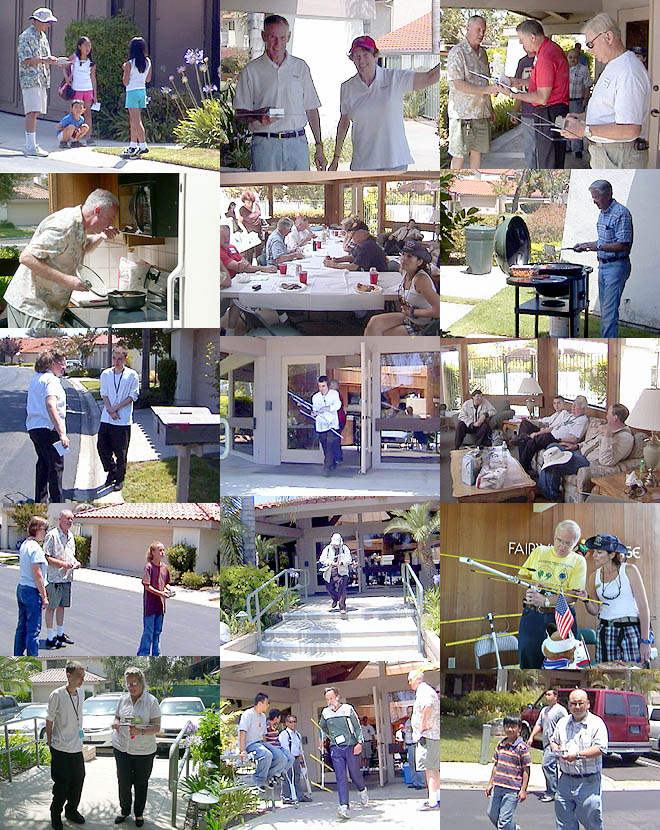
Photos above by Joe Moell KØOV and April Moell WA6OPS. Report below by Joe Moell KØOV.
ARDF 2-METER COURSE RESULTS -- 5 FOXES
Name and call Foxes Time
Bob Cooley KF6VSE 5 1:18:04
Scott Moore KF6IKO 5 2:29:15
Jay Thompson W6JAY 3 1:32:19
Bill Smathers KG6HXX 2 2:27:11
![]()
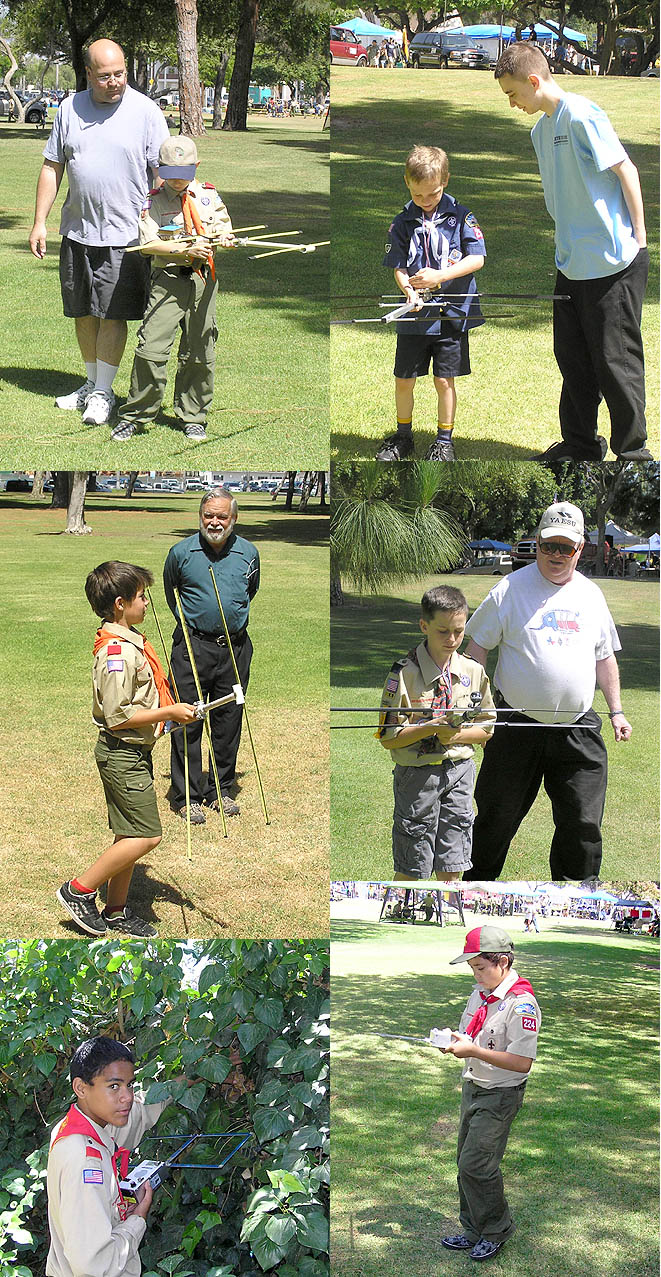
Report below and photos above by Joe Moell KØOV
![]()
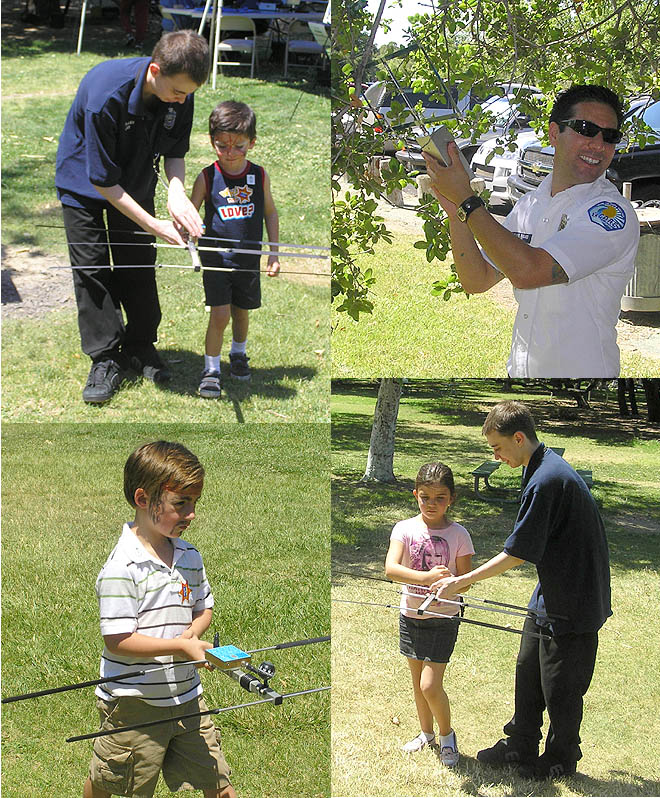
Report below and photos above by Joe Moell KØOV.
![]()

Report below and photos above by Joe Moell KØOV.
ARDF 2-METER COURSE RESULTS -- 5 FOXES
Name and call Foxes Time
Rob Preston KI6KYX 5 2:11:15
with Bill Preston KZ3G
John Frerichs N6VCW 4 1:08:45
Dick Palmer WB6JDH 4 1:27:07
with Otis Mc Coy KD6AXR, Lloyd Hendrickson KI6NQY and Norm Dickhoff KI6HLB
![]()
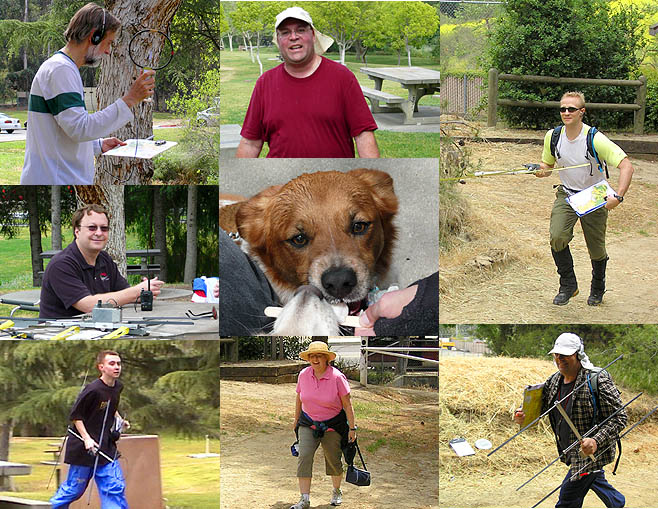
Report below and photos above by Joe Moell KØOV.
ARDF 2-METER COURSE RESULTS -- 5 FOXES
Name and call Foxes Time
Bob Cooley KF6VSE 4 1:35:20
Bill Smathers KG6HXX 4 1:46:45
Scott Moore KF6IKO 4 1:54:46
Brad Weyers 4 2:37:32
Jay Thompson W6JAY 3 1:45:18
Tom Gaccione WB2LRH 3 2:34:20
![]()
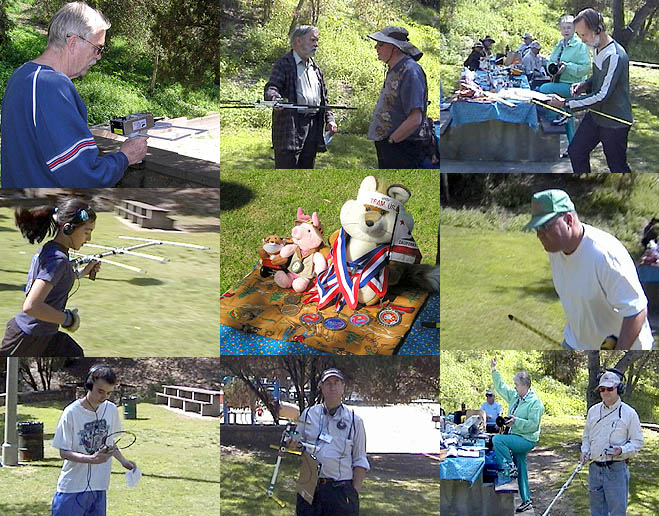
Report below and photos above by Joe Moell KØOV.
ARDF 2-METER COURSE RESULTS -- 5 FOXES
Name and call Foxes Time
Jay Thompson W6JAY 5 0:56:32
Tom Gaccione WB2LRH 5 1:01:06
Bob Cooley KF6VSE 5 1:05:50
Ross Howay 3 0:58:41
with Marvin Johnston KE6HTS
Monique Beringer 2 1:12:45
with Tim and Patricia Beringer
Steve Morse KI6HGH 2 2:38:38
Keith Horton KI6HLD 1 1:04:33
80-METER HUNT RESULTS (1 FOX)
Name and call Time
Bob Cooley KF6VSE 4:54
Jay Thompson W6JAY 5:58
![]()
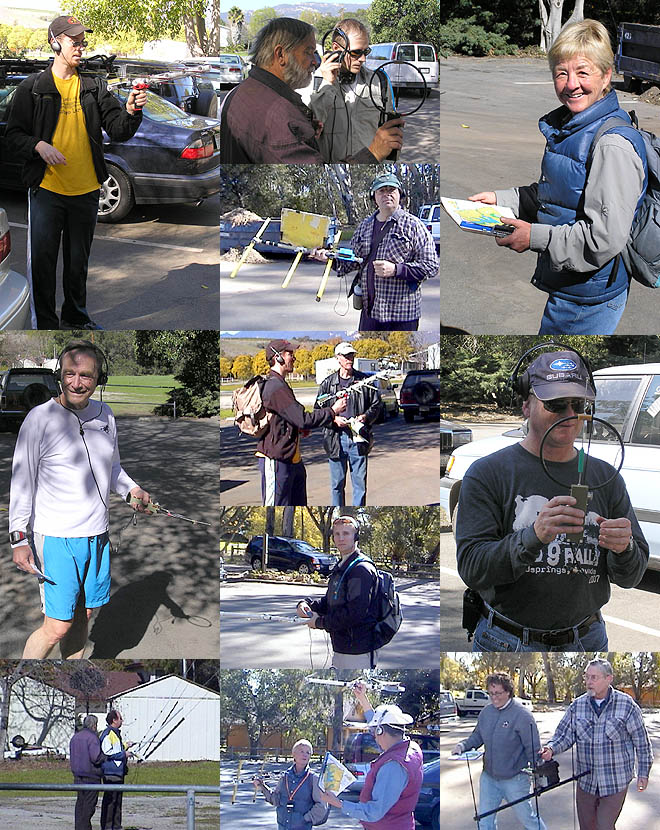
Report below and photos above by Joe Moell KØOV.
ARDF 2-METER COURSE RESULTS -- 5 FOXES
Name and call Foxes Time
Jay Hennigan WB6RDV 5 0:28:46
Scott Moore KF6IKO 5 0:56:46
Owen Roth 5 1:19:36
with Jeremy Roth
Sam Vigil WA6NGH 5 1:22:34
with Eve Vigil KF6NEV
Brad Weyers 5 1:24:12
Bill Smathers KG6HXX 5 1:34:57
Darryl Widman KF6DI 5 2:44:48
with Julianne Walsh KI6DYX
Steve Morse KI6HGH 4 2:46:30
Keith Horton KI6HLD 1 1:14:40
80-METER HUNT RESULTS (1 FOX)
Name and call Time
Jay Hennigan WB6RDV 12:07
Scott Moore KF6IKO 17:03
Brad Weyers 23:20
Sam Vigil WA6NGH ?
with Eve Vigil KF6NEV
![]()
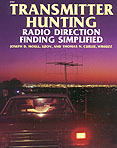 Go to Southern California ARDF -- Current radio-orienteering news and results
Go to Southern California ARDF -- Current radio-orienteering news and results Back to the Homing In home page
Back to the Homing In home page